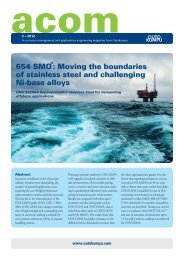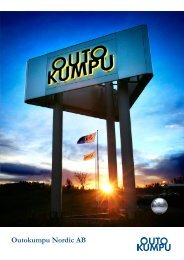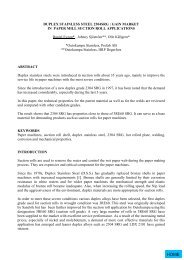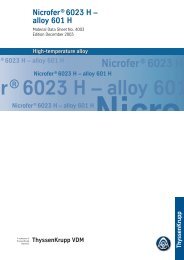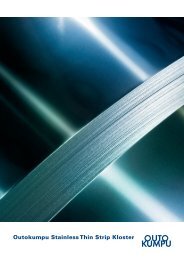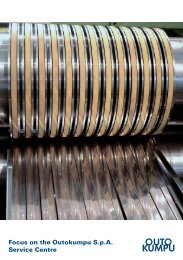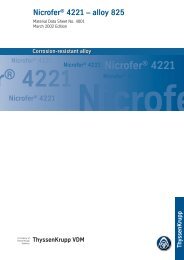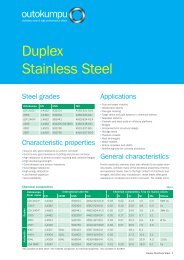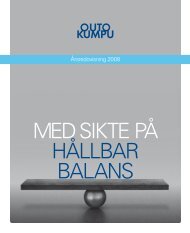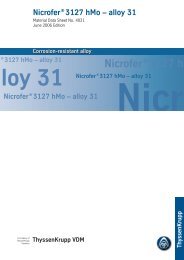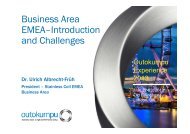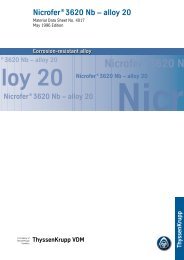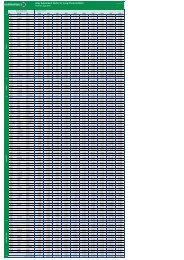Annual Report 2010 - Outokumpu
Annual Report 2010 - Outokumpu
Annual Report 2010 - Outokumpu
Create successful ePaper yourself
Turn your PDF publications into a flip-book with our unique Google optimized e-Paper software.
58<br />
Association). <strong>Outokumpu</strong> is a shareholder in two Finland-based strategic centres for science, technology and<br />
innovation – the Finnish Metals and Engineering Competence Cluster (FIMECC Ltd) and the Cluster for Energy and<br />
Environment (Cleen Ltd) – and is an active participant in associated research programmes. Three <strong>Outokumpu</strong>-related<br />
foundations – the <strong>Outokumpu</strong> Stainless Research Foundation in Sweden, the <strong>Outokumpu</strong> Stainless Research<br />
Foundation in the UK and the Technology Industries of Finland Centennial Foundation Fund for the Association of<br />
Finnish Steel and Metal Producers – provide support for researchers and students. In <strong>2010</strong>, <strong>Outokumpu</strong> also supported<br />
higher education and research by donating EUR 1 million to Finland's Aalto University.<br />
Research and development activities within <strong>Outokumpu</strong> resulted in the filing of four patent applications in <strong>2010</strong>. The<br />
development of methods to increase internal efficiency in R&D activities was also promoted, as was an initiative on the<br />
subject of Innovation management aimed at increasing R&D output.<br />
Product safety<br />
Consideration of issues that affect health and safety is important not only during the process of manufacturing stainless<br />
steel, but also when <strong>Outokumpu</strong> customers are further processing the material, when stainless steel products are being<br />
used, and when steel is returned for re-melting.<br />
As stainless steel is inert and non-reactive when employed correctly, potential health and safety impacts are extremely<br />
limited. This explains why stainless steel is so widely used in medical appliances and for equipment and tools employed<br />
in the food processing industry. In addition to long-term experience with stainless steel in a wide variety of applications,<br />
the material has also been tested and reviewed for possible health effects. The most recent review of this type was<br />
conducted by the Finnish Institute of Occupational Health and published in <strong>2010</strong>.<br />
<strong>Outokumpu</strong> manufactures stainless steel grades that are standardised and proven to be safe for their recommended use.<br />
To ensure that all products manufactured by the Group comply with the specified requirements, <strong>Outokumpu</strong>'s main<br />
production sites are certified in accordance with the ISO 9001 quality standard. Many of <strong>Outokumpu</strong>'s sales and<br />
distribution companies are also certified in accordance with this quality standard; in total 90% of <strong>Outokumpu</strong>'s personnel<br />
work in companies that are certified.<br />
REACH stipulates the safe use of chemicals<br />
In <strong>2010</strong>, thousands of chemicals had to be registered in REACH by their manufacturers or importers. Large quantities of<br />
test data and instructions for the safe use of chemicals were generated during this process. <strong>Outokumpu</strong> successfully<br />
submitted registrations for all the substances manufactured by the Group. As a user of chemical substances, we have<br />
actively approached our suppliers to ensure that they also fulfil their obligations under REACH. Products manufactured<br />
by <strong>Outokumpu</strong> do not contain any SVHC (Substances of Very High Concern) as defined by the European Chemicals<br />
Agency (ECHA).<br />
<strong>Outokumpu</strong> also takes account of specific end-use concerns. As there are restrictions on the use of metal compounds<br />
such as lead, cadmium, mercury and hexavalent chromium in the electronics and automotive sectors, the Group does<br />
not use these substances in its manufacturing processes.<br />
Safety and methods of risk evaluation<br />
Most stainless steels contain nickel, a metal classified as harmful in the EU. As stainless steel is inert, there is however<br />
no risk to either humans or the environment from stainless steel products in their normal use, a fact that has been<br />
demonstrated through both laboratory studies and the material's long history of usage.<br />
Unfortunately, the fact that manufactured steel is a very different material from the components used in its manufacture is<br />
sometimes not fully understood by regulators. For example, how can the same grade of stainless steel be judged<br />
<strong>Outokumpu</strong> <strong>Annual</strong> <strong>Report</strong> <strong>2010</strong> – Business – R&D




